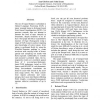Free Online Productivity Tools
i2Speak
i2Symbol
i2OCR
iTex2Img
iWeb2Print
iWeb2Shot
i2Type
iPdf2Split
iPdf2Merge
i2Bopomofo
i2Arabic
i2Style
i2Image
i2PDF
iLatex2Rtf
Sci2ools
COLING
2008
2008
Measuring Topic Homogeneity and its Application to Dictionary-Based Word Sense Disambiguation
The use of topical features is abundant in Natural Language Processing (NLP), a major example being in dictionary-based Word Sense Disambiguation (WSD). Yet previous research does not attempt to measure the level of topic cohesion in documents, despite assertions of its effects. This paper introduces a quantitative measure of Topic Homogeneity using a range of NLP resources and not requiring prior knowledge of correct senses. Evaluation is performed firstly by using the WordNet::Domains package to create word-sets with varying levels of homogeneity and comparing our results with those expected. Additionally, to evaluate each measure's potential value, the homogeneity results are correlated against those of 3 co-occurrence/dictionarybased WSD techniques, tested on 1040 Semcor and SENSEVAL sub-documents. Many low-moderate correlations are found to exist with several in the moderate range (above .40). These correlations surpass polysemy and senseentropy, the 2 most cited factors aff...
COLING 2008 | Computational Linguistics | Correlations Surpass Polysemy | Measure Achieves Correlations | Topic Homogeneity |
| Added | 29 Oct 2010 |
| Updated | 29 Oct 2010 |
| Type | Conference |
| Year | 2008 |
| Where | COLING |
| Authors | Ann Gledson, John Keane |
Comments (0)

